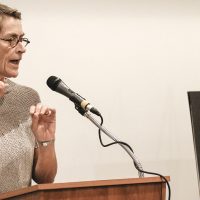
Despite Improved Access, Digital Divide Persists for Minority, Low-Income Students UCLA research shows battle for educational equity has shifted into a new space
By John McDonald
While students’ access to computers and the internet improved during the pandemic-affected and largely remote fall school term, a clear digital divide persists, especially among Black, Latino and low-income students, according to a new report by the UCLA Center for Neighborhood Knowledge.
“It appears that the lack of access has become less severe this fall than it was last spring, as schools have made adjustments to support remote learning,” said Paul Ong, the center’s director and an author of the report. “But it is also clear that a lack of access and real and troubling divide remains.”
This digital divide, the authors say, translates into students missing lessons, being unable to access materials and struggling to complete assignments — all of which have significant implications for long-term learning and success later in life.
The researchers used data from the U.S. Census Bureau’s Household Pulse Survey to provide a current look at household access to computers and the internet. Their findings show that the rate of limited digital access for households fell from a high of 42% during the panic and chaos of school closures last spring to about 31% this fall.
But the data also make clear that during the fall term, racial and economic inequality has remained significant, with African American and Latino households being 1.3 to 1.4 times as likely as white households to experience limited accessibility. Low-income households are most impacted by digital unavailability, with more than 2 in 5 having limited access to a computer or the internet.
In addition, since mid-October, the rate of digital inaccessibility has increased slowly but unmistakably. The researchers are concerned that the divide may worsen amid the current surge in COVID-19 infections and resulting restrictions.
“This new research details a persistent and troubling digital divide among students, with far-reaching implications for educational access and equitable opportunities,” said Tina Christie, the Wasserman Dean of the UCLA School of Education and Information Studies, which co-published the report with the Center for Neighborhood Knowledge at the UCLA Luskin School of Public Affairs.
“The pandemic has brought into focus the intimate connection between education and technological connectivity and, with it, the connection between connectivity and social justice,” Christie said. “The battleground for educational equity has now, and perhaps forever, shifted into a new space.”
According to Ong, a UCLA Luskin research professor, persistent digital inequality threatens to widen disparities in achievement as minority and low-income children become adults, contributing to an intergenerational reproduction of inequality.
“The disparities in limited technological resources for virtual learning are not just today’s education crisis,” Ong said. “Falling behind increases the achievement gap, which has long-term social and economic implications. To avoid this tragedy, we must act immediately and decisively to close the digital divide.”
COVID-19 and the Digital Divide in Virtual Learning, fall 2020, is a publication of the Center for Neighborhood Knowledge at the UCLA Luskin School of Public Affairs. The research brief was published in collaboration with the UCLA School of Education and Information Studies. Read the full research brief.
Contact: John McDonald
jmcdonald@gseis.ucla.edu









Leave a Reply
Want to join the discussion?Feel free to contribute!